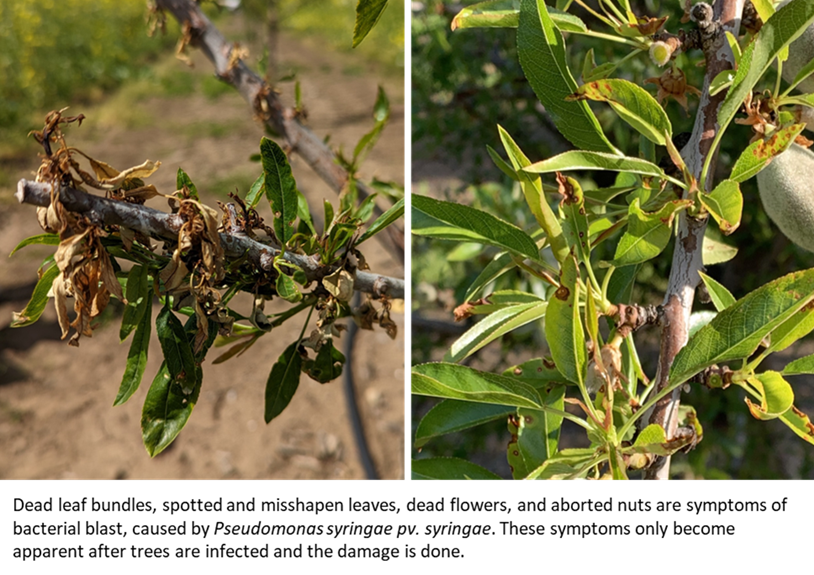Jaime Ott, UCCE Tehama, Shasta, Glenn, and Butte Counties
In 2023, the cold, wet weather during bloom and leaf-out resulted in bacterial blast damage in many Sacramento Valley almond orchards. If conditions this year are cold and wet during bloom, we may see a recurrence of blast: make a plan now to keep blast damage to a minimum.
The Bottom Line:
- Bacterial blast can be a problem when cold, wet conditions coincide with bloom or leaf-out.
- Copper resistance is common in the pathogen: spraying copper is ineffective for preventing blast in many orchards.
- Frost protection is the most economical prevention option and will help prevent damage from both frost and bacterial blast.
- The antibiotic kasugamycin (Kasumin®) is effective for preventing blast when applied up to 7 days before cold, wet weather. It will likely be available this year under an emergency exemption registration (Section 18) but is not currently labeled for almond under a full registration (Section 3).
The Details:
Pseudomonas syringae pv. syringae (Pseudomonas) is a bacterium which can infect all aboveground parts of an almond tree. If leaves, flowers, or spurs are infected, the resulting disease is bacterial blast. Pseudomonas is ubiquitous in orchards, so bacterial blast is likely to develop whenever environmental conditions are cold and wet, which favors this disease. Pseudomonas is spread by water hitting the trees, either from rain or sprinklers. If this wetting occurs at the same time as frost damage, Pseudomonas can enter the tree through cells damaged by freezing. Trees are especially susceptible to frost damage during bloom and leaf-out, when tender new growth is exposed to cold temperatures.
Preventing infection by Pseudomonas is the only way to control bacterial blast. Frost protection in an orchard is your best defense and your most inexpensive prevention strategy: if the trees are not damaged by frost, Pseudomonas will not be able to enter the tree to cause disease. As a second line of defense, research has shown that kasugamycin (Kasumin®) is effective for preventing bacterial blast when applied no more than 7 days before cold, wet weather. Note that kasugamycin is currently not labeled for use in almond and will only become available when a Section 18 exemption is approved for this year (Feb. 1). If it is approved for use, and if the weather warrants treatment, kasugamycin can be used as a preventative spray up to two times during bloom. For this spray, complete coverage is crucial for control: all tender new growth must be covered in a protective layer of the antibiotic for it to be effective. Any tissue left uncovered will be unprotected.
What about copper? Current work by UC researchers shows that copper-resistance is common in Pseudomonas throughout the state. Many of the orchards heavily affected by blast in 2023 received multiple dormant sprays containing copper. In some cases, mixing mancozeb with copper may provide some level of control, but research shows that this mixture is not as effective as kasugamycin and the copper can cause phytotoxicity.
For more information on bacterial blast, check out these articles at sacvalleyorchards.com
Bacterial blast/canker: What do we know? – an update on the factors predisposing orchards to damage by bacterial blast, and more details about control strategies for bacterial blast
Bacterial Blast and Canker – a good description of the various symptoms seen with bacterial blast



Leave a Reply